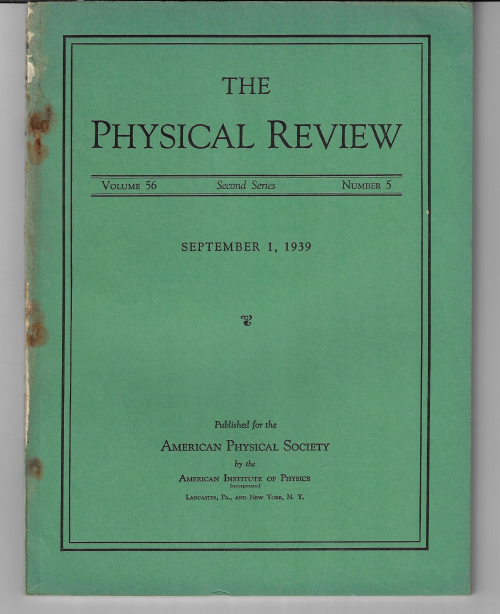Robert Oppenheimer and Hartland Snyder, “On continued gravitational contraction”,
Niels Bohr and J.A. Wheeler, “The mechanism of nuclear fission” both appearing in the Physical Review, September 1, 1939, Vol. 56, #5, pp. 426-50 and pp. 455-59, respectively.
First editions of these two papers, presented in the original wrappered issue of the great
Physical Review. Condition: the issue is not without its problems, and these are limited mostly to the spine cover, which is mostly worn away, though the spine itself is fine. THe only legible part of the lettering on the spine is the date on the spine bottom. Also there is some rust staining from the internal staples. Other than that the issue is really quite nice. All that said, I'm offering this at a fraction of what prettier copies are being sold for presently. $1250
The two papers appear together in a single issue of the journal, a remarkable set of achievements found in one small space--remarkable even more for the fact that 1939 (as with 1859, 1543, 1932, and 1948) is one of those remarkable single years in the history of science.
The Oppenheimer and Snyder (a graduate assistant) paper is one of the most prescient in the history of modern physics, correctly physically describing (where Chandrasekhar and Eddington in their discussions did not) what happens in a particular collapse of a neutron star, and still today reads as fresh and and brightly as it did in 1939. Really, it is an extraordinary work, and a foundation paper in the history of gravitation, the application of RT, singularity, and astrophysics. (The Southampton GR Explorer site nicely states it this way: "This paper has strong claims to being one of the most prophetic ever written in this field of research. Today, 60 years later, this paper needs little revision - even the terminology is undated!")

In an often-repeated quotation, they write, somewhat in irony and in a certain and understated manner on page 456: "The star thus tends to close itself off from any communication with a distant observer; only its gravitational field persists". And later: "When all thermonuclear sources of energy are exhausted, a sufficiently heavy star will collapse. Unless fission due to rotation, the radiation of mass, or the blowing off of mass by radiation, reduce the star's mass to the order of that of the sun, this contraction will continue indefinitely", they wrote.
Next comes Bohr and Wheeler, “The mechanism of nuclear fission” is the experimental foundation stone (on the basis of the liquid drop model of atomic nuclei) of nuclear fission and the great leap forward in the construction of the atomic bomb.
Condition: the paper of the spine of the publication is about one-third owrn away, otherwise this is a very nice copy.
From the abstract: "On the basis of the liquid drop model of atomic nuclei, an account is given of the mechanism of nuclear fission. In particular, conclusions are drawn regarding the variation from nucleus to nucleus of the critical energy required for fission, and regarding the dependence of fission cross section for a given nucleus on energy of the exciting agency. A detailed discussion of the observations is presented on the basis of the theoretical considerations. Theory and experiment fit together in a reasonable way to give a satisfactory picture of nuclear fission".




Comments